Philips 22PFH4109/88, 24PHH4109/88 User manual

Register your product and get support at www.philips.com/welcome
Manual de usuario

Contenido
1 Su nuevo televisor 3
1.1 EasyLink 3
2 Montaje 4
2.1Instrucciones de seguridad 4
2.2Soporte del televisor y montaje en pared 4
2.3Sugerencias de colocación 4
2.4Cable de alimentación 4
2.5Cable de antena 5
2.6Antena parabólica 5
3 Conexiones 6
3.1Consejos de conexión 6
3.2EasyLink HDMI CEC 7
3.3Interfaz común: CAM 8
3.4Receptor digital 8
3.5Receptor de satélite 9
3.6Sistema de cine en casa (HTS) 9
3.7Reproductor de Blu-ray Disc 11
3.8Reproductor de DVD 11
3.9Videoconsola 11
3.10Unidad flash USB 11
3.11Cámara de fotos 11
3.12Videocámara 12
3.13Ordenador 12
3.14Auriculares 12
4 Activar 14
4.1 Encendido o en modo de espera 14
5 Mando a distancia 15
5.1Descripción de los botones 15
5.2Pilas 15
5.3Limpieza 16
6 Canales de TV 17
6.1Visualización de canales de televisión 17
6.2Instalación de canales 21
7 Canales por satélite 25
7.1Visualización de canales por satélite 25
7.2Lista de canales por satélite 25
7.3Canales por satélite favoritos 25
7.4Bloqueo de canales por satélite 26
7.5Instalación de satélites 27
7.6Problemas con satélites 30
8 Guía de televisión 31
8.1 Uso de la guía de televisión 31
9 Fuentes 32
9.1Lista de fuentes 32
9.2Desde el modo de espera 32
9.3EasyLink 32
10 Temporizadores y reloj 33
10.1Temporizador 33
10.2Reloj 33
10.3Apagado automático 33
11 Fotos, vídeos y música 34
11.1 Desde un dispositivo USB 34
12 Ajustes 36
12.1Tono 36
12.2Tono personalizado 36
12.3Brillo 36
12.4Juego u ordenador 36
12.5Formato y bordes 36
12.6Ubicación 36
12.7Sonido 36
13 Accesorios 40
13.1Medio ambiente 40
13.2Recepción para PxHxxx9/PxTxxx9 40
13.3Recepción para PxKxxx9 41
13.4Pantalla 41
13.5Potencia 41
13.6Dimensiones y pesos_4009/41x9/4209 42
13.7Dimensiones y pesos_43x9 43
13.8Dimensiones y pesos_5219 43
13.9Dimensiones y pesos_5109 43
13.10Conectividad_20"-28"_4009/4109/4209/5219 43
13.11Conectividad_32"-39"_41x9 44
13.12Conectividad_40"-50"_41x9 44
13.13Conectividad_32"-55"_4309/5109/5209 44
13.14Sonido 45
13.15Multimedia 45
14 Software 46
14.1Actualización de software 46
14.2Versión de software 46
14.3Software de código fuente abierto 46
14.4Open source license 46
15 Solución de problemas y asistencia 65
15.1Solución de problemas 65
15.2Registrar 66
15.3Ayuda 66
15.4Ayuda en línea 67
15.5Atención al cliente/Reparar 67
16 Información de precaución y seguridad 68
16.1Seguridad 68
16.2Cuidado de la pantalla 69
17 Condiciones de uso, derechos de autor y licencias
70
17.1Condiciones de uso 70
17.2Derechos de autor y licencias 70
Índice 72
2

1
Su nuevo televisor
1.1
EasyLink
Con EasyLink puede controlar un dispositivo conectado, como un reproductor de Blu-ray Disc, con el mando a distancia del televisor.
EasyLink utiliza HDMI CEC para comunicarse con los dispositivos conectados.
3
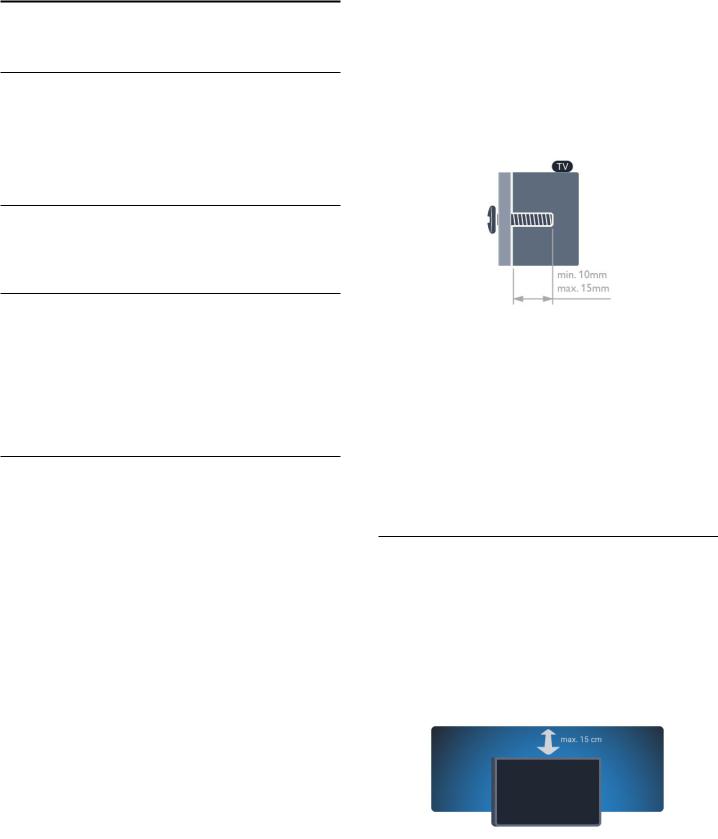
2
Montaje
2.1
Instrucciones de seguridad
Lea las instrucciones de seguridad antes de utilizar el televisor. En Ayuda, vaya a Seguridad y mantenimiento > Seguridad.
2.2
Soporte del televisor y montaje en pared
Soporte para TV
Puede consultar las instrucciones de montaje del soporte del televisor en la guía de inicio rápido que incluye el televisor. Si ha perdido la guía, puede descargarla en www.philips.com.
Utilice el número de producto del televisor para buscar la guía de inicio rápido correspondiente y descargarla.
Montaje en pared
El televisor admite también un soporte de montaje en pared compatible con VESA (se vende por separado).
Utilice el siguiente código VESA cuando compre el soporte de montaje en pared:
-20Pxx4109 - VESA MIS-F 75 x 75, M4
-22Pxx4109 - VESA MIS-F 75 x 75, M4
-23Pxx4009 - VESA MIS-F 75 x 75, M4
-24Pxx4109 - VESA MIS-F 75 x 75, M4
-28Pxx4109 - VESA MIS-F 100 x 100, M4
-32Pxx41x9 - VESA MIS-F 400 x 200, M6
-39Pxx41x9 - VESA MIS-F 400 x 200, M6
-40Pxx41x9 - VESA MIS-F 400 x 200, M6
-42Pxx41x9 - VESA MIS-F 400 x 200, M6
-47Pxx41x9 - VESA MIS-F 400 x 200, M6
-50Pxx41x9 - VESA MIS-F 400 x 400, M6
-22Pxx4209 - VESA MIS-F 75 x 75, M4
-24Pxx5219 - VESA MIS-F 75 x 75, M4
-32Pxx43x9 - VESA MIS-F 100 x 100, M4
-40Pxx43x9 - VESA MIS-F 200 x 200, M4
-50Pxx43x9 - VESA MIS-F 400 x 200, M6
-32Pxx5109 - VESA MIS-F 400 x 200, M6
-40Pxx5109 - VESA MIS-F 400 x 200, M6
-48Pxx5109 - VESA MIS-F 400 x 200, M6
-55Pxx5109 - VESA MIS-F 400x x 400, M6
-42Pxx5209 - VESA MIS-F 200 x 200, M6
-47Pxx5209 - VESA MIS-F 400 x 400, M6
-55Pxx5209 - VESA MIS-F 400 x 400, M6
Para fijar el soporte con seguridad, utilice tornillos de la longitud indicada en la ilustración.
Precaución
El montaje en pared requiere conocimientos técnicos y solo puede llevarse a cabo por personal cualificado. Además, el montaje en pared debe satisfacer los requisitos de seguridad correspondientes al peso del televisor. Antes de colocarlo, lea también las precauciones de seguridad.
TP Vision Europe B.V. no asume ninguna responsabilidad por el montaje inadecuado del televisor ni por cualquier montaje que provoque accidentes o lesiones.
2.3
Sugerencias de colocación
-Coloque el televisor en un lugar donde la luz no se refleje directamente en la pantalla.
-Coloque el televisor a una distancia máxima de 15 cm de la pared.
-La distancia ideal para ver la televisión es tres veces el tamaño diagonal de la pantalla. Mientras se está sentado, los ojos deberían quedar a la altura del centro de la pantalla.
4

2.4
Cable de alimentación
-Enchufe el cable de alimentación en el conector POWER de la parte posterior del televisor.
-Asegúrese de que el cable de alimentación esté bien insertado en el conector.
-Asegúrese de que el enchufe de la toma de alimentación de la pared permanece accesible en todo momento.
-Al desconectar el cable de alimentación, tire siempre del enchufe, nunca del cable.
Para 22PFx4209
Aunque este televisor tiene un consumo de energía muy bajo en el modo de espera, se debe desenchufar el enchufe del cable de alimentación si no se usa el televisor durante un largo período de tiempo para ahorrar energía.
2.5
Cable de antena
Inserte el conector de la antena con firmeza en la toma ANTENNA de la parte posterior del televisor.
Puede conectar su propia antena o conectar una señal de antena de un sistema de distribución de antena. Utilice un conector de antena RF coaxial IEC de 75 ohmios.
Utilice esta conexión de antena para las señales de entrada de TDT y TDC.
2.6
Antena parabólica
Inserte el conector de satélite tipo F en la conexión SAT de la parte posterior del televisor.
- Solo para televisores con sintonizador por satélite integrado.
5
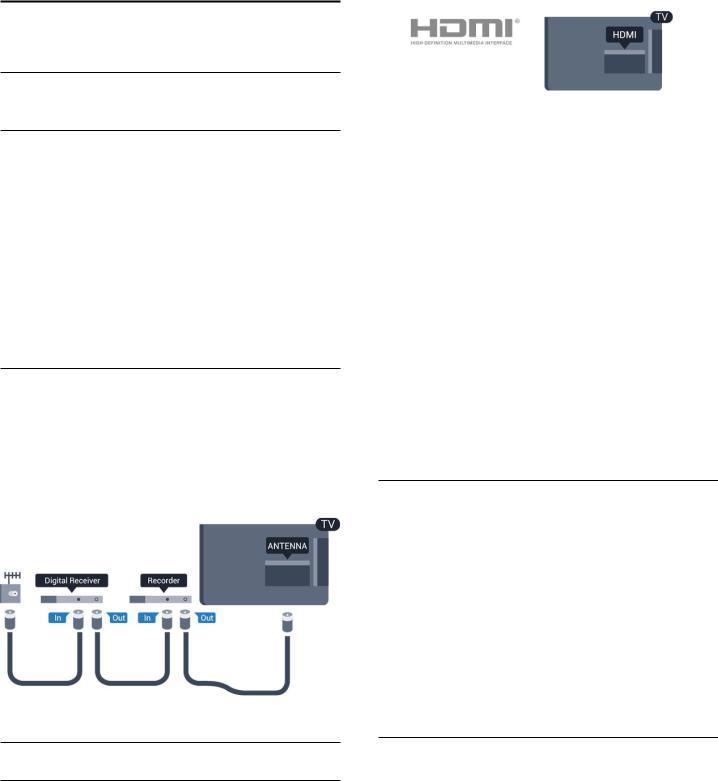
3
Conexiones
3.1
Consejos de conexión
Guía de conectividad
Conecte los dispositivos al televisor siempre con la conexión de mayor calidad posible. Además, utilice cables de alta calidad para garantizar
una buena transferencia de imagen y sonido.
Si necesita ayuda para conectar varios dispositivos al televisor, puede consultar la guía de conectividad para televisores de Philips. Esta guía ofrece información sobre cómo realizar la conexión y qué cables puede utilizar.
Visite www.connectivityguide.philips.com
Antena
Si dispone de un receptor o grabador digital, conecte los cables de antena para transmitir la señal de antena a través del receptor o grabador en primer lugar antes de que llegue al televisor. De esta forma, la antena y el receptor digital podrán enviar los posibles canales adicionales para que se graben en el grabador.
EasyLink HDMI CEC
Si los dispositivos están conectados con HDMI y disponen de EasyLink, puede controlarlos con el mando a distancia del televisor. Debe activar EasyLink HDMI CEC en el televisor y el dispositivo conectado.
DVI a HDMI
Use un adaptador de DVI a HDMI si su dispositivo solo tiene conexión DVI. Utilice uno de los conectores HDMI y, para el sonido, conecte un cable de audio L/R (miniconector de
3,5 mm) a la entrada de audio de la parte posterior del televisor.
Protección contra copia
Los cables DVI y HDMI admiten la protección de contenido digital de banda ancha (HDCP). HDCP es una señal de protección contra copia que impide copiar contenidos de DVD o Blu-ray Disc. Esta tecnología también es conocida como gestión de derechos digitales (DRM, del inglés Digital Rights Management).
HDMI ARC
La conexión HDMI 1 del televisor tiene HDMI ARC (canal de retorno de audio). Si el dispositivo, normalmente un sistema de cine en casa (HTS), también dispone de conexión HDMI ARC, conéctelo a la conexión HDMI 1 del televisor. Con la conexión HDMI ARC, no es necesario conectar un cable de audio adicional para que envíe el sonido de la imagen del televisor al sistema de cine en casa. La conexión HDMI ARC combina ambas señales.
Si prefiere desactivar el ARC en las conexiones HDMI, pulse , seleccione Configuración y pulse OK. Seleccione Ajustes de TV > Sonido > Avanzado > HDMI 1 - ARC.
HDMI
HDMI CEC
La conexión HDMI ofrece la mejor calidad de imagen y sonido. Un cable HDMI combina señales de vídeo y audio. Utilice un cable HDMI para las señales de televisión de alta definición (HD) o alta definición total (FHD). Para una calidad óptima de la transferencia de la señal, emplee un cable HDMI de alta velocidad y no use un cable HDMI de más de 5 m de largo.
Euroconector
SCART es una conexión de buena calidad. La conexión SCART se puede utilizar para señales de vídeo CVBS y RGB, pero no para señales de televisión de alta definición (HD). La conexión SCART combina señales de vídeo y audio.
Utilice el cable con adaptador SCART suministrado para conectar el dispositivo.
6

Salida de audio, óptica
La salida de audio óptica es una conexión de sonido de alta calidad. Esta conexión óptica puede transmitir canales de audio 5.1. Si su dispositivo, normalmente un sistema de cine en casa (HTS), no tiene conexión HDMI ARC, puede utilizar esta conexión con la conexión de entrada de audio óptica del HTS. La conexión de salida de audio óptica envía el sonido desde el televisor al HTS.
Configuración de EasyLink
El televisor tiene activada la función EasyLink de manera predeterminada. Asegúrese de que todos los ajustes HDMI-CEC se hayan configurado correctamente en los dispositivos con EasyLink conectados. EasyLink podría no funcionar con dispositivos de otras marcas.
Denominación de HDMI-CEC en otras marcas
La funcionalidad HDMI-CEC posee diferentes nombres en función de la marca. Algunos ejemplos son: Anynet, Aquos Link, Bravia Theatre Sync, Kuro Link, Simplink y Viera Link. No todas las marcas son totalmente compatibles con EasyLink.
Los nombres de marcas de HDMI CEC de ejemplo son propiedad de sus respectivos propietarios.
Puede ajustar el tipo de señal de salida de audio para adaptarla a la función de audio del sistema de cine en casa.
Si el sonido no coincide con el vídeo de la pantalla, puede ajustar la sincronización de audio y vídeo.
3.2
EasyLink HDMI CEC
EasyLink
Con EasyLink puede controlar un dispositivo conectado con el mando a distancia del televisor. EasyLink utiliza HDMI CEC (control de electrónica de consumo) para comunicarse con los dispositivos conectados. Los dispositivos deben ser compatibles con HDMI CEC y deben conectarse mediante una conexión HDMI.
7
Control de dispositivos
Para controlar un dispositivo conectado mediante HDMI y configurarlo con EasyLink, seleccione el dispositivo (o su actividad) en la lista de conexiones del televisor.
Pulse SOURCES, seleccione un dispositivo conectado a una conexión HDMI y pulse OK.
Una vez seleccionado el dispositivo, podrá controlarlo con el mando a distancia del televisor. No obstante, los botones yOPTIONS y otros botones del televisor no se transmiten al dispositivo.
Si el botón que necesita no se encuentra en el mando a distancia del televisor, puede seleccionarlo en el menú Opciones.
Pulse OPTIONS y seleccione Controles en la barra de menú. En la pantalla, seleccione el botón del dispositivo que necesita y pulse OK.
Puede que algunos botones del dispositivo muy específicos no estén disponibles en el menú Controles.
Nota: solo los dispositivos que admiten la función Mando a distancia de EasyLink responderán al mando a distancia del televisor.

Ajustes EasyLink
El televisor tiene activados todos los ajustes de EasyLink. Puede desactivar los ajustes de EasyLink de forma independiente.
EasyLink
Para desconectar EasyLink por completo:
1.Pulse , seleccione Configuración y pulse OK.
2.Seleccione Ajustes de TV > Ajustes generales > EasyLink.
3.Seleccione EasyLink.
4.Seleccione Apagado y pulse OK.
5.Pulse , varias veces si fuera necesario, para cerrar el menú.
Mando a distancia de EasyLink
Si desea que los dispositivos se comuniquen, puede desactivar el mando a distancia de EasyLink por separado.
Puede controlar varios de los dispositivos conectados compatibles con HDMI-CEC con el mando a distancia del televisor.
En el menú de ajustes de EasyLink, seleccione Mando a distancia de EasyLink y seleccione Apagado.
Reproducción con un solo toque
Cuando reproduzca un dispositivo compatible con HDMI-CEC, el televisor se enciende desde el modo de espera y cambia automáticamente a la fuente correcta.
Modo de espera con un solo toque
Al pulsar en el mando a distancia del televisor, tanto el televisor como todos los dispositivos compatibles con HDMICEC cambian automáticamente al modo de espera.
Control de audio del sistema
Si conecta un dispositivo compatible con HDMI-CEC que incluye altavoces mediante el conector HDMI ARC, puede seleccionar escuchar el audio del televisor a través de este dispositivo en lugar de a través de los altavoces del televisor.
3.3
Interfaz común: CAM
CI+
Este televisor admite el acceso condicional mediante CI+.
Con CI+ puede ver programas de alta definición premium, como películas y deportes, ofrecidos por emisoras de televisión digital de su región. Estos programas son codificados por la emisora de televisión y descodificados con un módulo CI+ de prepago.
Las emisoras de televisión digital proporcionan este módulo CI+ (módulo de acceso condicional, CAM) cuando se suscribe a sus
programas premium. Estos programas tienen un alto nivel de protección contra copia.
Póngase en contacto con una emisora de televisión digital para obtener más información sobre los términos y condiciones.
CAM
Inserción de un módulo CAM
Apague el televisor antes de insertar un CAM.
Fíjese en el CAM para realizar la inserción en la dirección correcta. Si la inserción fuese incorrecta, se podría dañar el CAM y el televisor.
Utilice la ranura de interfaz común del televisor para insertar la tarjeta del CAM.
Con la parte frontal de la tarjeta a la vista, inserte suavemente el CAM tanto como sea posible.
Deje la tarjeta dentro de la ranura de forma permanente.
Es posible que transcurran unos minutos antes de que se active el CAM. La desinstalación del CAM desactivará el servicio en el televisor.
Si ha insertado un CAM y ha pagado las tarifas de suscripción (los métodos de conexión pueden variar), podrá visualizar la emisión de televisión. El CAM insertado es exclusivo para su televisor.
3.4
Receptor digital
Utilice dos cables de antena para conectar la antena del receptor por cable (receptor digital) y el televisor.
8

Junto al conector de la antena, añada un cable HDMI para conectar el receptor digital al televisor.
También puede utilizar un cable SCART si el receptor digital no tiene conexión HDMI.
Apagado automático
Si solo utiliza el mando a distancia del receptor por cable, desconecte este temporizador automático. Hágalo para evitar que el televisor se apague automáticamente transcurridos
4 horas si no pulsa ningún botón del mando a distancia del televisor.
Para desactivar el temporizador de desconexión, pulse , seleccione Configuración y pulse OK.
Seleccione Ajustes de TV > Ajustes generales > Apagado automático y mueva la barra deslizante a la posición de apagado.
3.5
Receptor de satélite
- Solo para televisores con sintonizador por satélite integrado.
Conecte el cable de la antena parabólica al receptor de satélite.
Junto al conector de la antena, añada un cable HDMI para conectar el dispositivo al televisor.
También puede utilizar un cable SCART si el dispositivo no tiene conexión HDMI.
Apagado automático
Si solo utiliza el mando a distancia del receptor por cable, desconecte este temporizador automático. Hágalo para evitar que el televisor se apague automáticamente transcurridos
4 horas si no pulsa ningún botón del mando a distancia del televisor.
Para desactivar el temporizador de desconexión, pulse , seleccione Configuración y pulse OK.
Seleccione Ajustes de TV > Ajustes generales > Apagado automático y mueva la barra deslizante en la posición de apagado.
3.6
Sistema de cine en casa (HTS)
Conexión del HTS
Utilice un cable HDMI para conectar un sistema de cine en casa (HTS) al televisor. Puede conectar un Soundbar de Philips al HTS con un reproductor de discos integrado.
También puede utilizar un cable SCART si el dispositivo no tiene conexión HDMI.
HDMI ARC
Si su sistema de cine en casa tiene una conexión HDMI ARC, podrá utilizar cualquier entrada de HDMI del televisor para conectarlo. Con HDMI ARC no es necesario conectar un cable de audio adicional. La conexión HDMI ARC combina ambas señales.
Todas las conexiones HDMI del televisor pueden ofrecer la señal ARC (canal de retorno de audio) pero, una vez conectado el sistema de cine en casa, el televisor solo podrá enviar la señal ARC a esta conexión HDMI.
Si el sistema de cine en casa no dispone de conexión HDMI ARC, añada un cable óptico de audio (Toslink) para enviar el sonido de la imagen del televisor al sistema de cine en casa.
Sincronización de audio y vídeo (sinc.)
Si el sonido no coincide con la imagen que se muestra en
9

pantalla, en la mayoría de los sistemas de cine en casa con reproductor de discos es posible configurar un retardo para sincronizar el sonido con el vídeo.
Ajustes de salida de audio
Retardo de salida de audio
Con un sistema de cine en casa (HTS) conectado al televisor, la imagen que se muestra y el sonido procedente del HTS deberían estar sincronizados.
Sincronización automática de audio y vídeo
Con sistemas de cine en casa de Philips recientes, la sincronización de audio y vídeo se realiza automáticamente y siempre es correcta.
Retardo de sincronía de audio
Es posible que en algunos sistemas de cine en casa se deba ajustar el retardo de audio para sincronizar el audio y el vídeo. En el sistema de cine en casa, aumente el retardo hasta que la imagen coincida con el sonido. Es posible que necesite un retardo de 180 ms. Para obtener más información, consulte el manual del usuario del sistema de cine en casa. Tras configurar el retardo del HTS, deberá desactivar la opción Retardo de salida de audio del televisor.
Para desactivar la opción Retardo de salida de audio:
1.Pulse , seleccione Configuración y pulse OK.
2.Seleccione Ajustes de TV > Sonido > Avanzado > Retardo de salida de audio.
3.Seleccione Apagado y pulse OK.
4.Pulse , varias veces si fuera necesario, para cerrar el menú.
Compensación de salida de audio
Si no puede establecer un retardo en el sistema de cine en casa, puede configurar el televisor para que se sincronice con el sonido. Puede establecer una compensación del tiempo necesario para que el sistema de cine en casa procese el sonido de la imagen del televisor. Puede ajustar la compensación en intervalos de 1 ms. El ajuste máximo es 12 ms. El ajuste de Retardo de salida de audio debe estar activado.
Para sincronizar el sonido del televisor:
1.Pulse , seleccione Configuración y pulse OK.
2.Seleccione Ajustes de TV > Sonido > Avanzado > Compensación de salida de audio.
3.Utilice la barra deslizante para ajustar el desplazamiento de sonido y pulse OK.
4.Pulse , varias veces si fuera necesario, para cerrar el menú.
Formato de salida de audio
Si tiene un sistema de cine en casa (HTS) con capacidad de procesamiento de sonido multicanal como Dolby Digital, DTS® o similar, ajuste el formato de salida de audio en Multicanal. Con Multicanal, el televisor puede enviar la señal de sonido multicanal comprimida de un canal de televisión o un reproductor conectado al sistema de cine en casa. Si tiene un sistema de cine en casa sin procesamiento de sonido multicanal, seleccione Estéreo.
Para ajustar el formato de salida de audio:
1.Pulse , seleccione Configuración y pulse OK.
2.Seleccione Ajustes de TV > Sonido > Avanzado > Formato de salida de audio.
3.Seleccione Multicanal o Estéreo.
4.Pulse , varias veces si fuera necesario, para cerrar el menú.
Nivelación de salida de audio
Utilice el ajuste Nivelación de salida de audio para nivelar el volumen (sonoridad) del televisor y el sistema de cine en casa cuando cambie entre uno y otro. Las diferencias de volumen pueden estar provocadas por diferencias en el procesamiento de sonido.
Para nivelar la diferencia de volumen:
1.Pulse , seleccione Configuración y pulse OK.
2.Seleccione Ajustes de TV > Sonido > Avanzado > Nivelación de salida de audio.
3.Si la diferencia de volumen es grande, seleccione Más. Si la diferencia de volumen es pequeña, seleccione Menos.
Pulse , varias veces si fuera necesario, para cerrar el menú.
La nivelación de salida de audio afecta a las señales de sonido Salida de audio óptica y HDMI-ARC.
Problemas de sonido con el HTS
Sonido con mucho ruido
Si ve un vídeo desde una unidad flash USB u ordenador que haya conectado, puede que el sonido del sistema de cine en casa se distorsione.
1.Pulse , seleccione Configuración y pulse OK.
2.Seleccione Ajustes de TV > Sonido > Avanzado > Formato de salida de audio.
No hay sonido
Si no oye el sonido del televisor en el sistema de cine en casa, compruebe lo siguiente:
-Compruebe si ha conectado el cable HDMI a un conector HDMI ARC del sistema de cine en casa. Todos los conectores HDMI del televisor son HDMI ARC.
-Compruebe que el ajuste HDMI ARC del televisor está
10
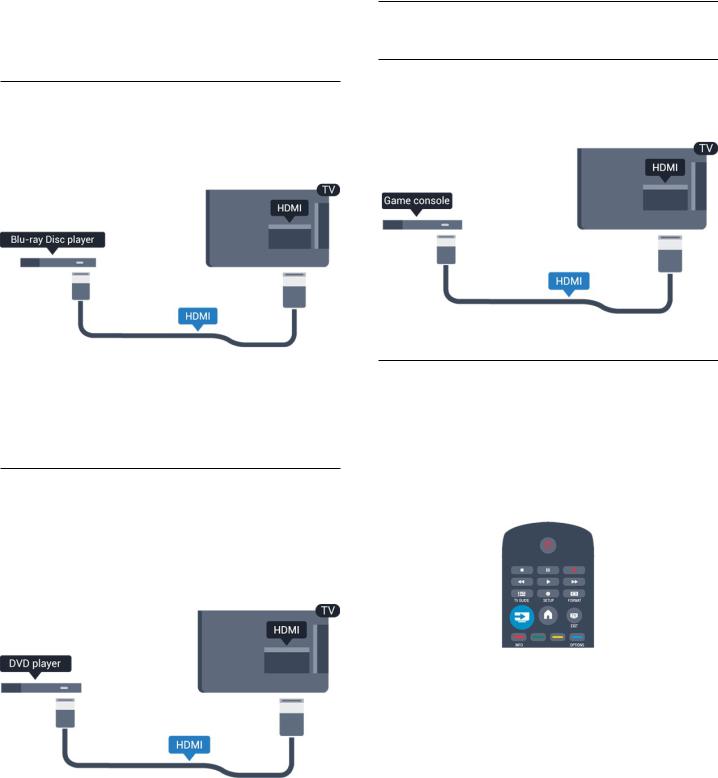
encendido.
Vaya a > Configuración > Ajustes de
TV > Sonido > Avanzado > HDMI 1 - ARC.
3.7
Reproductor de Blu-ray Disc
Utilice un cable HDMI de alta velocidad para conectar el reproductor de Blu-ray Disc al televisor.
Si el reproductor de Blu-ray Disc dispone de EasyLink HDMI CEC, puede controlar el reproductor con el mando a distancia del televisor.
3.8
Reproductor de DVD
Utilice un cable HDMI para conectar el dispositivo al reproductor de DVD.
También puede utilizar un cable SCART si el dispositivo no tiene conexión HDMI.
Si el reproductor de DVD está conectado mediante HDMI y dispone de EasyLink CEC, puede controlar el reproductor con el mando a distancia del televisor.
3.9
Videoconsola
HDMI
Para disfrutar de una calidad óptima, conecte la videoconsola al televisor mediante un cable HDMI de alta velocidad.
3.10
Unidad flash USB
Puede ver fotos o reproducir vídeos y música desde una unidad flash USB conectada.
Inserte una unidad flash USB en una de las conexiones USB del televisor mientras está encendido.
El televisor detecta la unidad flash y abre una lista que muestra su contenido.
Si la lista de contenido no aparece automáticamente, pulseSOURCES, seleccione USB y pulse OK.
Para dejar de ver el contenido de la unidad flash USB, pulseEXIT o seleccione otra actividad.
Para desconectar la unidad flash USB, puede extraerla en cualquier momento.
11
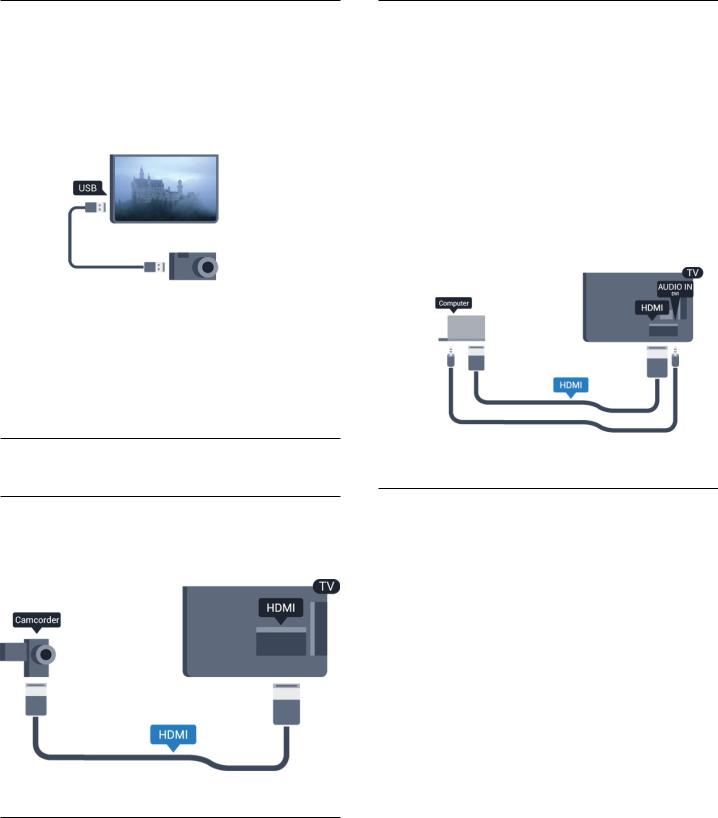
3.11
Cámara de fotos
Para ver las fotos almacenadas en su cámara de fotos digital, puede conectar la cámara directamente al televisor.
Utilice una de las conexiones USB del televisor para realizar la conexión. Encienda la cámara después de realizar la conexión.
Si la lista de contenido no aparece automáticamente, pulseSOURCES, seleccione USB y pulse OK.
Puede que haya que configurar la cámara para transferir su contenido con el protocolo de transferencia de imágenes (PTP, del inglés Picture Transfer Protocol). Consulte el manual de usuario de la cámara de fotos digital.
3.12
Videocámara
HDMI
Para obtener la mejor calidad, utilice un cable HDMI para conectar la videocámara al televisor.
3.13
Ordenador
Conectar
Puede conectar el ordenador al televisor y utilizar el televisor como monitor de PC.
Con HDMI
Utilice un cable HDMI para conectar el ordenador al televisor.
Con DVI a HDMI
También puede utilizar un adaptador de DVI a HDMI para conectar el PC a la toma HDMI y un cable de audio L/R (miniconector de 3,5 mm) a la toma AUDIO IN L/R de la parte posterior del televisor.
Ajustes
Ajuste ideal del monitor
Si el ordenador se añade como tipo de dispositivo Ordenador en el menú Fuentes (lista de conexiones), el televisor se configura con el ajuste Ordenador idóneo de manera automática.
Si utiliza el ordenador para ver películas o para jugar a juegos, puede que desee configurar de nuevo el televisor en el ajuste ideal para ver la televisión o jugar.
Para configurar manualmente el ajuste óptimo del televisor:
1.Pulse , seleccione Configuración y pulse OK.
2.Seleccione Ajustes de TV > Imagen > Avanzado > Juego u ordenador y pulse OK.
3.Seleccione Juego (para juegos) u Ordenador (para ver una película) y pulse OK.
4.Pulse , varias veces si fuera necesario, para cerrar el menú.
No olvide cambiar de nuevo el ajuste Juego u ordenador a Ordenador cuando termine de jugar.
12
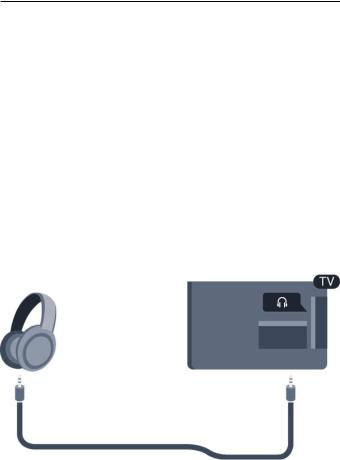
3.14
Auriculares
Puede conectar unos auriculares a la conexión del televisor. La conexión es un miniconector de 3,5 mm. Puede ajustar el volumen de los auriculares de forma independiente.
Para ajustar el volumen:
1.Pulse , seleccione Configuración y pulse OK.
2.Seleccione Ajustes de TV > Sonido > Volumen auricular y pulse OK.
3.Pulse las flechas (arriba) o (abajo) para ajustar el volumen.
4.Pulse , varias veces si fuera necesario, para cerrar el menú.
13
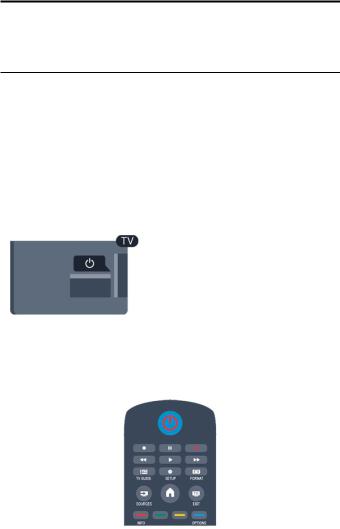
4
Activar
4.1
Encendido o en modo de espera
Asegúrese de enchufar la alimentación de la parte posterior del televisor antes de encenderlo.
Si el indicador rojo está apagado, pulse el botón de encendido del lateral del televisor para activar el modo de espera. El indicador rojo se iluminará.
Con el televisor en modo de espera, pulse en el mando a distancia para encender el televisor.
Cambio al modo de espera
Para activar el modo de espera en el televisor, pulse en el mando a distancia.
Apagar
Para apagar el televisor, pulse el botón de encendido del lateral del televisor. El indicador rojo se apaga; el televisor sigue conectado a la corriente, pero consume una cantidad de energía mínima.
Para apagar el televisor completamente, desenchufe el cable de alimentación de la toma de corriente.
Cuando desenchufe el cable de alimentación, tire siempre de la clavija, nunca del cable. Asegúrese de poder acceder sin dificultad a la clavija de alimentación, al cable de alimentación y a la toma de corriente en todo momento.
14

5
Mando a distancia
5.1
Descripción de los botones
Parte superior
1. En espera / Encendido
Para encender el televisor o volver al modo de espera.
Botones de 2. reproducción
-Reproducir , para iniciar la reproducción.
-Pausar , para realizar una pausa en la reproducción.
-Detener , para detener la reproducción.
-Retroceder , para retroceder.
-Avanzar rápido , para avanzar.
3. TV GUIDE
Para abrir o cerrar la guía de televisión.
4. SETUP
Para abrir el menú de configuración.
5. FORMAT
Para abrir o cerrar el menú de formato de imagen.
Parte central
1. SOURCES
Para abrir o cerrar el menú de fuentes (la lista de dispositivos conectados).
2. Botones de colores
La función de los botones es seguir las instrucciones que aparecen en pantalla.
3. INFO
Para abrir o cerrar la información de los programas.
4. BACK
Para volver al canal seleccionado anteriormente. Para cerrar un menú sin cambiar ningún ajuste.
5. HOME
Para abrir o cerrar el menú de inicio.
6. EXIT
Para seguir viendo la televisión.
7. OPTIONS
Para abrir o cerrar el menú de opciones.
8. Botón OK
Para confirmar una selección o ajuste.
9. Flechas/botones de navegación
Para desplazarse hacia arriba, abajo, izquierda o derecha.
10. LIST
Para abrir o cerrar la lista de canales.
Parte inferior
1. Volumen
Para ajustar el nivel volumen.
2. Botones numéricos y teclado
Para seleccionar directamente un canal de televisión o introducir texto.
3. SUBTITLE
Para activar o desactivar los subtítulos o para establecerlos en Automático.
4. Canal
Para cambiar al canal anterior o siguiente de la lista de canales, abrir la página anterior o siguiente en el teletexto o reproducir el capítulo anterior o siguiente de un disco.
5. Silenciar
Para silenciar el sonido o restaurarlo.
6. TEXT
Para abrir o cerrar el servicio de teletexto.
15

5.2
Pilas
1.Deslice la tapa en la dirección que muestra la flecha.
2.Sustituya las pilas antiguas por dos pilas alcalinas AAA LR03 de 1,5 V. Asegúrese de que los extremos + y - de las pilas están alineados correctamente.
3.Vuelva a colocar la tapa de las pilas.
4.Deslícela hasta oír un clic.
Si no va a utilizar el mando a distancia durante un largo período de tiempo, quite las pilas.
Deseche las pilas de forma segura y conforme a las instrucciones al respecto.
5.3
Limpieza
El mando a distancia cuenta con un revestimiento resistente a los arañazos.
Para limpiar el mando a distancia, utilice un paño suave humedecido. Nunca utilice sustancias como alcohol, productos químicos o detergentes domésticos en el mando a distancia.
16

6
Canales de TV
6.1
Visualización de canales de televisión
Cambio de canal
Para ver canales de televisión, pulse . El televisor muestra el último canal de televisión que haya visto.
También puede pulsar para abrir el menú de inicio, seleccionar TV y pulsar OK.
Para cambiar de canal, pulse o . Si conoce el número del canal, escriba el número con los botones numéricos.
Pulse OK una vez introducido el número para cambiar de canal.
Para volver al canal que estaba viendo antes, pulse .
Para cambiar a un canal desde una lista de canales
Mientras ve un canal de televisión, pulse LIST para abrir la lista de canales.
La lista de canales puede tener varias páginas con canales. Para ver la página anterior o siguiente, pulse + o .
Para cerrar las listas de canales sin cambiar de canal, pulse LIST de nuevo.
Canales de radio
Si está disponible la emisión digital, se instalarán las emisoras de radio digitales durante la instalación. El procedimiento para cambiar de emisora de radio es idéntico al de los canales de televisión.
Lista de canales
Visualización de toda la lista de canales
1.Mientras ve un canal de televisión, pulse LIST para abrir la lista de canales.
2.Pulse OPTIONS para abrir el menú de opciones.
3.Seleccione Lista y, a continuación, Todos, Favoritos, Radio y
Nuevos canales.
Canales favoritos
Puede crear una lista de canales favoritos que contenga solo los canales que desea ver. Si se selecciona la lista de canales favoritos, solo se verán sus canales favoritos cuando cambie de un canal a otro.
Creación de la lista de canales favoritos
1.Mientras ve un canal de televisión, pulse LIST para abrir la lista de canales.
2.Seleccione el canal que desee marcar como favorito y
pulse OPTIONS.
3.Seleccione Añadir favoritos y pulse OK. El canal seleccionado se marca con .
4.Para finalizar, pulse . Los canales se añaden a la lista Favoritos.
5.Para quitar un canal de la lista de favoritos, seleccione el canal marcado con , y, a continuación, pulse OPTIONS, seleccione Eliminar favoritos y pulse OK.
Reordenar
Puede reordenar (cambiar de posición) los canales de la lista de favoritos.
1.En la lista de canales Favoritos, resalte el canal cuya posición desea cambiar.
2.Pulse OPTIONS.
3.Seleccione Reordenar y pulse OK.
4.Seleccione el canal que desee reordenar y pulse OK.
5.Pulse los botones de navegación para mover el canal seleccionado a otra posición y pulse OK.
6.Cuando haya terminado, pulse OPTIONS.
7.Seleccione Salir de reordenar y pulse OK.
Puede resaltar otro canal y repetir el proceso.
Adición o eliminación de favoritos en otras listas de canales
Puede marcar canales y emisoras de radio como favoritos en las listas de canales Todos, Radio y Nuevo.
En estas listas, seleccione un canal que desee añadir a la lista de favoritos y pulse OPTIONS. A continuación, seleccione
Añadir favoritos y pulse OK.
El canal seleccionado se marca con .
Para quitar un canal de la lista de favoritos, seleccione Eliminar favoritos y pulse OK.
17

Renombrar canales
Puede cambiar de nombre canales en la lista de canales.
1.Seleccione de una de las listas de canales el canal al que desea cambiar el nombre.
2.Pulse OPTIONS.
3.Seleccione Renombrar y pulse OK.
Bloqueo de un canal
Para impedir que los niños vean un canal o un programa determinado, puede bloquear los canales o programas en función de su clasificación por edades.
Bloqueo de un canal
Puede bloquear un canal para impedir que los niños puedan verlo. Para ver un canal bloqueado, debe introducir el código de bloqueo infantil. No es posible bloquear programas de dispositivos conectados.
Para bloquear un canal:
1.Mientras ve un canal de televisión, pulse LIST para abrir la lista de canales.
2.En cualquier lista, seleccione el canal que desee bloquear.
3.Pulse OPTIONS y seleccione Bloquear canal. En una lista de canales, un canal bloqueado se marca con un candado .
Para desbloquear un canal, seleccione el canal bloqueado en la lista de canales. Pulse OPTIONS y seleccione la opción Desbloquear canal. Deberá introducir el código de bloqueo infantil.
Control de padres
Para impedir que los niños vean un programa inadecuado para su edad, puede utilizar una clasificación por edades.
Algunas emisoras digitales han clasificado sus programas por edades. Cuando la clasificación de un programa sea igual o superior a la edad que usted haya establecido, el programa se bloqueará.
Para ver un programa bloqueado, debe introducir el código de bloqueo infantil. El control de padres se aplica a todos los canales.
Para establecer una clasificación de edad:
1.Pulse , seleccione Configuración y pulse OK.
2.Seleccione Ajustes de canal > Bloqueo infantil > Control de padres y pulse OK.
3.Introduzca un código de bloqueo infantil de cuatro dígitos y confírmelo. Ya puede establecer una clasificación por edades.
4.Establezca la edad y pulse OK.
5.Pulse , varias veces si fuera necesario, para cerrar el menú.
6.Para desactivar la clasificación parental, seleccione Ninguno como ajuste de edad.
El televisor solicitará el código para desbloquear el programa. En el caso de determinadas emisoras u operadores, el televisor solo bloquea los programas con una clasificación superior.
Establecer o cambiar el código
Para establecer el código de bloqueo o cambiar el código actual:
1.Pulse , seleccione Configuración y pulse OK.
2.Seleccione Ajustes de canal > Bloqueo infantil > Cambiar código y pulse OK.
3.Si ya ha establecido un código, introduzca el código de bloqueo infantil actual y, a continuación, el código nuevo dos veces.
Se establece el nuevo código.
¿Ha olvidado el código?
Para omitir el código de bloqueo infantil e introducir uno nuevo en caso de que lo olvide, introduzca 8888.
Formato de pantalla
Si aparecen barras negras en las partes superior e inferior y en los laterales de la imagen, puede ajustar el formato de imagen para que llene toda la pantalla.
Para cambiar el formato de imagen:
1.Mientras ve un canal de televisión, pulse para abrir el menú Formato de imagen.
2.Seleccione un formato de la lista y pulse OK.
Las siguientes opciones de formato pueden estar disponibles en función de la imagen en pantalla:
- Automático
Ajusta el formato de imagen de acuerdo con la fuente de entrada.
- Super zoom
Elimina las franjas negras a los lados de las emisiones 4:3. La imagen se ajusta al tamaño de la pantalla.
- Ampliación de imagen 16:9
Aumenta el formato 4:3 a 16:9. No se recomienda para alta definición o PC.
- Pantalla panorámica
Amplía el formato de la imagen a 16:9.
- Sin escala
Modo experto para entradas de alta definición o PC. Imagen píxel por píxel. Pueden aparecer barras negras en imágenes de ordenador.
- 4:3
Muestra el formato clásico 4:3.
18

Teletexto
Páginas del teletexto
Para abrir el teletexto mientras ve un canal de televisión, pulse
TEXT.
Para cerrarlo, vuelva a pulsar TEXT.
Seleccionar una página de teletexto
Para seleccionar una página:
1.Introduzca el número de página con los botones numéricos.
2.Utilice los botones de flecha para desplazarse.
3.Pulse un botón de color para seleccionar una de las secciones codificadas por colores que figuran en la parte inferior de la pantalla.
Subpáginas del teletexto
Una página de teletexto puede contener varias subpáginas, cuyo número se muestra junto al de la página principal, separado por una barra.
Para seleccionar una subpágina, pulse o .
Páginas de teletexto T.O.P.
Algunos centros emisores ofrecen teletexto T.O.P.
Para abrir páginas de teletexto T.O.P. desde el teletexto, pulse OPTIONS y seleccione Resumen T.O.P.
Páginas favoritas
El televisor crea una lista con las últimas 10 páginas del teletexto que ha abierto. Puede volver a abrirlas fácilmente en la columna Páginas del teletexto favoritas.
1.En el teletexto, seleccione la estrella que hay en la esquina superior izquierda de la pantalla para mostrar la columna de páginas favoritas.
2.Pulse (abajo) o (arriba) para seleccionar un número de página y pulse OK para abrirla.
Puede borrar la lista con la opción Borrar páginas favoritas.
Búsqueda en el teletexto
Puede seleccionar una palabra y explorar el teletexto para ver las repeticiones de esta palabra.
1.Abra una página de teletexto y pulse OK.
2.Mediante los botones de flecha, seleccione una palabra o un número.
3.Pulse OK de nuevo para pasar inmediatamente a la siguiente repetición.
4.Para pasar a las siguientes repeticiones, vuelva a pulsar OK.
5. Para dejar de buscar, pulse (arriba) hasta que no haya nada seleccionado.
Teletexto procedente de dispositivos conectados
Algunos dispositivos con recepción de canales de televisión también ofrecen teletexto.
Para acceder al teletexto desde dispositivos conectados:
1.Pulse , seleccione el dispositivo y pulse OK.
2.Mientras ve un canal en el dispositivo, pulse OPTIONS, seleccione Mostrar botones del dispositivo, seleccione el botón y pulse OK.
3.Pulse para ocultar los botones del dispositivo.
4.Para cerrar el teletexto, vuelva a pulsar .
MHEG (solo Reino Unido)
Algunas emisoras de televisión digital ofrecen servicios exclusivos de teletexto digital o televisión interactiva en sus canales de televisión digital. Dichos servicios funcionan como un teletexto normal con los botones de flechas, de colores y numéricos para seleccionar y desplazarse.
Para cerrar el teletexto digital, pulse .
Opciones del teletexto
En el teletexto, pulse OPTIONS para seleccionar las siguientes opciones:
- Congelar página/Descongelar página
Para detener la rotación automática de subpáginas.
- Pantalla dual/Pantalla completa
Para mostrar el canal de televisión y el teletexto a la vez.
- Resumen T.O.P.
Para abrir el teletexto T.O.P.
- Ampliar/Vista normal
Para ampliar la página de teletexto y facilitar la lectura.
- Mostrar
Para mostrar información oculta en una página.
- Recorrer subpáginas
Para recorrer subpáginas si están disponibles.
- Idioma
Para cambiar el grupo de caracteres que utiliza el teletexto y mostrarlo correctamente.
- Teletexto 2.5
Para activar el teletexto 2.5, con más colores y mejores gráficos.
Configuración del teletexto
Idioma del teletexto
Algunos centros emisores de televisión digitales tienen disponibles varios idiomas de teletexto.
Para ajustar los idiomas principal y secundario del teletexto:
19

1.Pulse , seleccione Configuración y pulse OK.
2.Seleccione Ajustes de canal > Idiomas.
3.Seleccione Teletexto principal o Teletexto secundario.
4.Seleccione los idiomas que prefiera para el teletexto.
5.Pulse , varias veces si fuera necesario, para cerrar el menú.
Teletexto 2.5
Teletexto 2.5, disponible en determinados canales, ofrece más colores y mejores gráficos. Teletexto 2.5 está activado como ajuste de fábrica estándar.
Para desactivar el teletexto 2.5:
1.Pulse TEXT.
2.Mientras ve el teletexto, pulse OPTIONS.
3.Seleccione Teletexto 2.5 > Apagado.
4.Pulse , varias veces si es necesario, para cerrar el menú.
Subtítulos e idiomas
Subtítulos
Activación de los subtítulos
Para abrir el menú de subtítulos, pulse SUBTITLE. Puede alternar entre Subtítulos desactivados, Subtítulos activados o Automático.
Para mostrar los subtítulos cuando el programa emitido no esté en su idioma (el idioma que ha establecido para el televisor), seleccione Automático. Además, este ajuste mostrará los subtítulos cuando silencie el sonido con .
En los canales analógicos, los subtítulos deben estar disponibles en el teletexto.
Subtítulos de canales digitales
En los canales digitales, no es necesario ajustar los subtítulos en el teletexto.
Los canales digitales pueden ofrecer varios idiomas para los subtítulos de un programa. Puede ajustar los idiomas principal y secundario que prefiera para los subtítulos. Si hay disponibles subtítulos en uno de estos idiomas, el televisor los mostrará.
Si no hay disponible ninguno de estos idiomas preferidos para los subtítulos, puede seleccionar otro idioma que esté disponible.
Para ajustar los idiomas principal y secundario de los subtítulos:
1.Pulse , seleccione Configuración y pulse OK.
2.Seleccione Ajustes de canal e Idiomas.
3.Seleccione Idioma para los subtítulos principales o Idioma para los subtítulos secundarios y pulse OK.
4.Seleccione un idioma y pulse OK.
5. Pulse , varias veces si fuera necesario, para cerrar el menú.
Para seleccionar un idioma de los subtítulos cuando no hay disponible ninguno de los preferidos:
1.Pulse OPTIONS.
2.Seleccione Idioma de subtítulos, elija el idioma temporal que desee y pulse OK.
Subtítulos de canales analógicos
En los canales analógicos, debe activar los subtítulos manualmente en cada canal.
1.Cambie a un canal y pulse TEXT para abrir el teletexto.
2.Introduzca el número de página de los subtítulos, normalmente 888.
3.Vuelva a pulsar TEXT para cerrar el teletexto.
Si selecciona Encendido en el menú de subtítulos cuando visualice este canal analógico, se mostrarán los subtítulos si están disponibles.
Para saber si un canal es analógico o digital, cambie al canal y abra Estado en el menú Opciones.
Idiomas de audio
Los canales de televisión digital pueden emitir audio con varios idiomas para un programa. Puede ajustar idiomas de audio principal y secundario. Si el audio está disponible en uno de estos idiomas, el televisor cambiará a ese audio.
Si no hay disponible ninguno de estos idiomas preferidos para el audio, puede seleccionar otro idioma que esté disponible.
Para ajustar los idiomas principal y secundario del audio:
1.Pulse , seleccione Configuración y pulse OK.
2.Seleccione Ajustes de canal e Idiomas.
3.Seleccione Idioma de audio principal o Idioma audio secundario y pulse OK.
4.Seleccione un idioma y pulse OK.
5.Pulse , varias veces si fuera necesario, para cerrar el menú.
Para seleccionar un idioma de audio si no hay ninguno de los preferidos disponible:
1.Pulse OPTIONS.
2.Seleccione Idioma de audio, seleccione el idioma temporal de audio que desee y pulse OK.
Idiomas de audio para personas con deficiencias visuales o auditivas
Algunos canales de televisión digitales emiten subtítulos y audio especiales adaptados para las personas con deficiencias auditivas o visuales.
Idioma de menú
Para cambiar el idioma de los menús y mensajes del televisor: 1. Pulse , seleccione Configuración y pulse OK.
20

2.Seleccione Ajustes de TV > Ajustes generales > Idioma de menú y pulse OK.
3.Seleccione el idioma que desee y pulse OK.
4.Pulse , varias veces si fuera necesario, para cerrar el menú.
6.2
Instalación de canales
Actualizar canales
Actualización automática
Si recibe canales digitales, puede ajustar el televisor para que actualice automáticamente la lista con los canales nuevos. También puede iniciar una actualización de canales usted mismo.
Actualización automática de canal
Una vez al día, a las seis de la mañana, el televisor actualizará los canales y guardará los canales nuevos. Dichos canales se almacenarán en la lista de canales Todos y también en la lista de canales Nuevos. Los canales vacíos se eliminarán.
Si se encuentran nuevos canales o si se actualizan o eliminan canales, se mostrará un mensaje al iniciar el televisor. El televisor debe estar en modo de espera para actualizar los canales automáticamente.
Para desactivar el mensaje que se muestra al iniciar:
1.Pulse , seleccione Configuración y pulse OK.
2.Seleccione Ajustes de canal y pulse OK.
3.Seleccione Instalación de canales > Mensaje de actualización de canales > Apagado.
Para desactivar la función Actualización automática de canal:
1.Pulse , seleccione Configuración y pulse OK.
2.Seleccione Ajustes de canal y pulse OK.
3.Seleccione Instalación de canales > Actualización automática de canal > Apagado.
Inicio de la actualización
Para iniciar una actualización manualmente:
1.Pulse , seleccione Configuración y pulse OK.
2.Seleccione Buscar canal y pulse OK.
3.Seleccione Actualizar canales y siga las instrucciones en pantalla. La actualización puede tardar unos minutos.
En algunos países, la actualización automática de canales se realiza mientras se ve la televisión o en cualquier momento cuando el televisor está en modo de espera.
Nuevos canales
Los canales nuevos que se añaden con la actualización de canales automática se pueden encontrar fácilmente en la lista de canales Nuevo. Los mismos canales nuevos también se almacenan en la lista de canales Todos o Radio.
Los canales nuevos se mantienen en la lista Nuevo mientras no los marque como favoritos o los vea por primera vez.
Reinstalar canales
Puede buscar y reinstalar canales y dejar el resto de ajustes del televisor sin modificar. También puede realizar una nueva instalación completa del televisor.
Si se ha establecido un código de bloqueo infantil, deberá introducir dicho código para poder reinstalar los canales.
Reinstalar canales
Para reinstalar solo los canales:
1.Pulse , seleccione Configuración y pulse OK.
2.Seleccione Buscar canal > Reinstalar canales y pulse OK.
3.Seleccione el país donde se ha instalado el televisor.
4.Seleccione Antena (TDT) o Cable (TDC). La búsqueda de canales puede tardar unos minutos. Siga las instrucciones en pantalla.
Instalación completa
Para volver a realizar una instalación completa del televisor:
1.Pulse , seleccione Configuración y pulse OK.
2.Seleccione Ajustes de TV > Ajustes generales > Reinstalar TV y pulse OK. La instalación puede tardar unos minutos. Siga las instrucciones en pantalla.
Ajustes de fábrica
La opción Ajustes de fábrica restablece los ajustes originales de imagen y sonido del televisor. Para restablecer los ajustes de fábrica:
1.Pulse , seleccione Configuración y pulse OK.
2.Seleccione Ajustes de TV > Ajustes generales > Ajustes de fábrica y pulse OK.
3.Pulse OK para confirmar.
4.Pulse , varias veces si fuera necesario, para cerrar el menú.
Copia de la lista de canales
Introducción
La opción Copia de la lista de canales está dirigida a distribuidores y usuarios expertos. En algunos países, la opción Copia de la lista de canales solo está disponible para copiar canales por satélite.
Gracias a la opción Copia de la lista de canales puede copiar los canales instalados de un televisor a otro televisor Philips de la misma gama. Dicha opción le permite ahorrar tiempo al evitar la búsqueda de canales cargando una lista predefinida de estos en un televisor. Utilice una unidad flash USB con un mínimo de
1 GB.
Condiciones
21

-Ambos televisores deben ser de la misma gama y del mismo año.
-Ambos televisores deben tener el mismo tipo de hardware. Puede comprobarlo en la placa de identificación del televisor situada en la parte posterior del mismo. Normalmente se indica como Q . . . LA.
-Ambos televisores deben tener versiones de software compatibles.
Versión actual
Puede comprobar la versión actual del software del televisor en la opción Información del software actual en > Configuración > Ajustes de software.
Copia de la lista de canales
Para copiar una lista de canales:
1.Encienda el televisor que tiene los canales instalados. Conecte un dispositivo de memoria USB.
2.Pulse , seleccione Configuración y pulse OK.
3.Seleccione Ajustes de TV > Ajustes generales > Copia de la lista de canales > Copiar en dispositivo USB y pulse OK. Para copiar la lista de canales desde este televisor, puede que se le pida que introduzca el código de bloqueo infantil que introdujo durante la instalación.
4.Cuando finalice la copia, desconecte el dispositivo de memoria USB.
Ahora ya podrá cargar la lista de canales copiada en otro televisor Philips.
Carga de la lista de canales
Carga de una lista de canales copiada
En función de si ha instalado ya el televisor o no, debe utilizar un método distinto para cargar una lista de canales.
En un televisor que aún no tenga los canales instalados
1.Enchufe el cable de alimentación para que comience la instalación, y seleccione el idioma y el país. Omita la búsqueda de canales y finalice la instalación.
2.Conecte el dispositivo de memoria USB donde se encuentra la lista de canales del otro televisor.
3.Para iniciar la carga de la lista de canales, pulse , seleccione
Configuración y pulse OK.
4.Seleccione Ajustes de TV > Ajustes generales > Copia de la lista de canales > Copiar en televisor y pulse OK. Puede que se le pida que introduzca el código de bloqueo infantil de este televisor.
5.El televisor le avisará cuando la lista de canales se haya copiado correctamente. Desconecte el dispositivo de memoria USB.
En un televisor que ya tiene instalados los canales:
1. Compruebe el ajuste de país del televisor. Para hacerlo, pulse
, seleccione Configuración y pulse OK. Seleccione Buscar canal > Reinstalar canales y pulse OK. Pulse y, a continuación, Cancelar para abandonar la búsqueda de canales. Si el ajuste de país es el correcto, continúe con el paso 2.
Si el ajuste de país no es correcto, debe llevar a cabo una reinstalación. Para iniciar la reinstalación, pulse , seleccione
Configuración y pulse OK. Seleccione Ajustes de TV > Ajustes generales > Reinstalar TV > OK. Seleccione el país correcto, omita la búsqueda de canales y finalice la instalación. Cuando termine, continúe con el paso 2.
2.Conecte el dispositivo de memoria USB donde se encuentra la lista de canales del otro televisor.
3.Para iniciar la carga de la lista de canales, pulse , seleccione
Configuración y pulse OK.
4.Seleccione Ajustes de TV > Ajustes generales > Copia de la lista de canales > Copiar en televisor y pulse OK. Puede que se le pida que introduzca el código de bloqueo infantil de este televisor.
5.El televisor le avisará cuando la lista de canales se haya copiado correctamente. Desconecte el dispositivo de memoria USB.
TDT o TDC
Recepción de TDT o TDC
Si dispone tanto de recepción TDT como TDC en su país, y el televisor está preparado tanto para la TDT como para la TDC de su país, habrá seleccionado una de las dos opciones al instalar los canales.
Si desea cambiar la configuración de TDT para iniciar una nueva instalación de canales:
1.Pulse , seleccione Configuración y pulse OK.
2.Seleccione Ajustes de canal y pulse OK.
3.Seleccione Instalación de canales > Conexión de la antena > Antena (TDT) o Cable (TDC) y pulse OK.
4.Seleccione el ajuste de TDT que desee.
5.Pulse , varias veces si fuera necesario, para cerrar el menú.
Instalación de canales TDC
Para una mayor facilidad de uso, los ajustes de TDC se establecen automáticamente.
Si su proveedor de TDC le ha proporcionado valores de TDC específicos, el ID de red o la frecuencia de red, introduzca estos valores cuando el televisor se lo solicite durante la instalación. Puede que sea necesario ajustar la búsqueda (exploración completa o rápida) o introducir un nivel de símbolo específico en el menú Ajustes durante la instalación. Para ajustar un Nivel de símbolo, primero debe ajustar el nivel de símbolo en Manual.
Conflictos con los números de canales
En algunos países, diferentes canales de televisión (emisoras) pueden tener el mismo número de canal. Durante la instalación, el televisor muestra la lista de conflictos con los números de canales. Debe seleccionar el canal de televisión que desea
22
